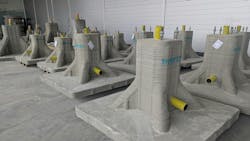National Grid Collaborates on UK Trial of 3D-Printed Substation Foundations
National Grid is partnering with Hyperion Robotics and the University of Sheffield to trial the use of 3D-printed concrete foundations for electricity substations. The project, which is the first of its kind in the UK, aims to assess whether the technology can help reduce construction-related carbon emissions and lower costs associated with substation infrastructure.
If implemented more broadly, the approach could reduce material use and emissions over time. Preliminary estimates suggest that over a ten-year period, it could result in savings of up to 705 tons of concrete, 323 tons of CO₂, and approximately £1.7 million in construction costs, compared to traditional methods.
According to the project partners, the 3D-printed foundation design offers potential efficiencies across several areas:
-
70% reduction in concrete volume
-
80% decrease in soil displacement
-
65% lower embodied carbon emissions
-
70% weight reduction
-
50% reduction in on-site labor hours
The foundations will be manufactured by Hyperion Robotics in Finland and undergo full-scale testing at the University of Sheffield. Additional field testing is scheduled for 2025 at National Grid’s Deeside Centre for Innovation in North Wales.
Dr Muhammad Shaban, Lead Innovation Engineer at National Grid Electricity Transmission, said, “Our collaboration with Hyperion Robotics is a real step forward in achieving more innovative construction practices which align with our bold and ambitious commitments on sustainability. This trial of low-carbon 3D printed alternatives to concrete for substation foundations is the first of its kind in the UK, and has the potential to transform construction activities across the industry. The project has been funded by Ofgem’s Network Innovation Allowance, which provides an allowance to energy network licensees to fund innovation projects that have the potential to deliver longer term financial and environmental benefits for consumers.”
